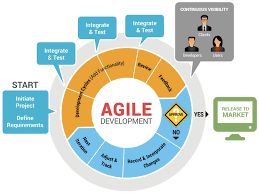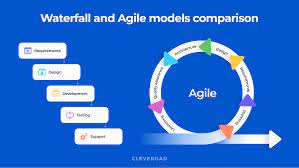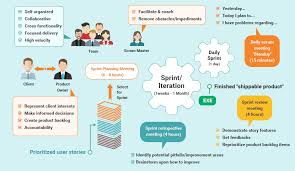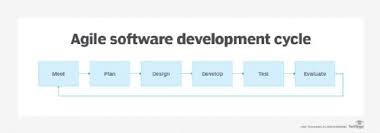The Benefits of an Agile Development Environment
Agile development has revolutionized the way software is created and delivered. An agile development environment is characterized by its iterative and incremental approach to software development. Here are some of the key benefits of adopting an agile methodology:
Rapid Response to Change
One of the main advantages of agile development is its ability to quickly adapt to changes in requirements or market conditions. By breaking down projects into smaller, manageable chunks, teams can respond to feedback and make adjustments as needed without derailing the entire project.
Increased Collaboration
Agile methodologies emphasize collaboration among team members, stakeholders, and customers. This leads to better communication, shared understanding of goals, and a more cohesive team working towards a common objective.
Improved Quality
Agile promotes continuous testing and feedback throughout the development process. This results in higher quality products as issues are identified early on and can be addressed promptly.
Enhanced Flexibility
With agile development, teams have the flexibility to reprioritize tasks based on changing requirements or emerging opportunities. This allows for greater adaptability in a fast-paced environment.
Customer Satisfaction
By involving customers in the development process through regular feedback and demos, agile teams can ensure that the final product meets customer expectations. This customer-centric approach leads to higher satisfaction levels and increased loyalty.
In conclusion, an agile development environment offers numerous benefits that can lead to more efficient project delivery, improved product quality, and increased customer satisfaction. By embracing agility in software development, organizations can stay ahead of the curve in today’s dynamic business landscape.
7 Essential Tips for Creating an Effective Agile Development Environment
- Prioritize customer satisfaction and collaboration.
- Embrace changing requirements, even late in development.
- Deliver working software frequently, with a preference for shorter timescales.
- Communicate and work closely with your team members daily.
- Build projects around motivated individuals. Give them the environment and support they need, and trust them to get the job done.
- Reflect on how to become more effective as a team regularly, then tune and adjust behavior accordingly.
- Simplify tasks by breaking them down into smaller pieces for easier management.
Prioritize customer satisfaction and collaboration.
In an agile development environment, prioritizing customer satisfaction and collaboration is essential for success. By actively involving customers in the development process and seeking their feedback, teams can ensure that the final product meets their needs and expectations. Additionally, fostering collaboration among team members, stakeholders, and customers promotes better communication, shared understanding of project goals, and a more cohesive team working towards a common objective. Emphasizing customer satisfaction and collaboration not only leads to higher-quality products but also strengthens relationships with customers and enhances overall project success.
Embrace changing requirements, even late in development.
In an agile development environment, it is crucial to embrace changing requirements, even late in the development process. By remaining flexible and open to adjustments throughout the project lifecycle, teams can respond effectively to evolving needs and market demands. Embracing change late in development allows for continuous improvement and ensures that the final product meets the most current requirements and expectations. This adaptability is a key principle of agile methodologies, enabling teams to deliver high-quality solutions that align closely with stakeholders’ needs.
Deliver working software frequently, with a preference for shorter timescales.
In an agile development environment, it is crucial to deliver working software frequently, with a preference for shorter timescales. By breaking down projects into smaller, manageable increments and focusing on delivering tangible results regularly, teams can ensure that progress is visible and feedback can be incorporated quickly. This iterative approach not only keeps the project on track but also allows for adjustments to be made promptly, leading to higher quality outcomes and increased customer satisfaction.
Communicate and work closely with your team members daily.
In an agile development environment, it is crucial to communicate and work closely with your team members on a daily basis. By fostering open communication and collaboration within the team, you can ensure that everyone is aligned on project goals, progress, and any potential challenges. Daily interactions help to build trust, enhance teamwork, and facilitate quick decision-making, ultimately leading to more efficient project execution and successful outcomes.
Build projects around motivated individuals. Give them the environment and support they need, and trust them to get the job done.
In an agile development environment, it is crucial to build projects around motivated individuals who are empowered to succeed. By providing them with the necessary support and creating a conducive work environment, teams can thrive and deliver exceptional results. Trusting these individuals to take ownership of their tasks and complete them effectively fosters a sense of responsibility and accountability, leading to increased productivity and success in project outcomes.
Reflect on how to become more effective as a team regularly, then tune and adjust behavior accordingly.
Regularly reflecting on how to become more effective as a team and then tuning and adjusting behavior accordingly is a fundamental principle of agile development environments. By taking the time to assess team dynamics, communication processes, and individual contributions, teams can identify areas for improvement and make necessary adjustments to enhance overall effectiveness. This continuous reflection and adaptation not only fosters a culture of continuous improvement but also ensures that the team remains agile and responsive to changing requirements and challenges.
Simplify tasks by breaking them down into smaller pieces for easier management.
Breaking tasks down into smaller pieces is a fundamental principle of agile development that can greatly enhance project management efficiency. By simplifying tasks into more manageable chunks, teams can focus on completing one small piece at a time, leading to better organization, clearer progress tracking, and increased productivity. This approach not only makes it easier to assign responsibilities and track progress but also allows for quicker adjustments and adaptations as needed throughout the development process.




